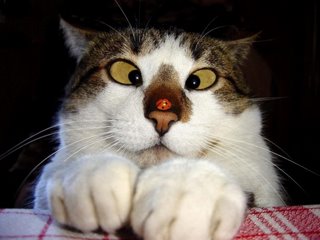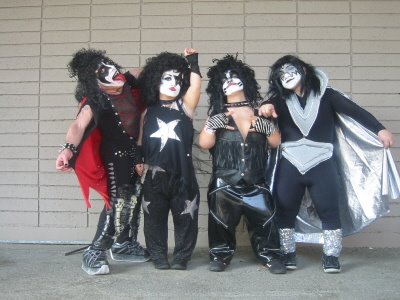
Q. Why do Japanese people remove their shoes when they commit suicide?
A. The simple answer is that they are copying what they see in ‘trendy dramas’ where suicides are common and shoes are often removed. The origin of the practice probably lies in the same place as the idea of taking off your shoes when you enter a house. Shoes are considered dirty and when one steps up to enter a house one leaves one’s dirty shoes behind. Taking off one’s shoes before one jumps symbolizes leaving the filth and dirt of the material world behind. Removing one’s shoes also serves the practical purpose of showing that your death was not an accident.
Q. Why do so many Japanese people (and yours truly) turn red when they drink alcohol?
A. More than 50% of Asians have a strong sensitivity to alcohol. What it all comes down to is an enzyme called acetaldehyde dehydrogenase, which is crucial for the breaking down of alcohol. Some people will tell you that many Asians lack the enzyme, but that’s not entirely true. The real problem is that they have a ‘defective’ copy of the gene that produces it, so their enzymes act extremely slowly.
Before it is acted upon by acetaldehyde dehydrogenase, alcohol is turned into a substance known as acetaldehyde. It is this substance (and not alcohol) that turns many Asians’ faces red. In people with the slow-acting enzyme, acetaldehyde is broken down at only about half the regular rate. Acetaldehyde also causes nausea, malaise, and headaches in many people. People with the slow-acting enzyme do not however, get drunk more quickly, because the alcohol itself not broken down any more slowly.
Acetaldehyde is also a probable reason for the relatively low alcoholism rates in Asia. Their strong reactions to it cause many people to stop drinking before they get too drunk.
Q. Why do so many Japanese women walk pigeon-toed? Does this have anything to do with Japan's low birth-rate?
A. Walking pigeon-toed is considered feminine in Japan, and is an affectation rather than a physical characteristic. Some people have suggested that it is because their legs are deformed from sitting in seiza (on your shins with your legs folded under you) but this is simply untrue. The real answer is that it is a holdover from the days when people still wore kimono. If you walk normally while wearing one, the kimono tends to comes open so for modesty people began walking pigeon-toed. Even though people no longer wear kimono, a shuffling walk with one's feet turned inward is still considered modest, feminine, and even cute.

Q. Why do anime characters have such big eyes?
A. The practice of drawing anime characters with unusually large eyes dates back to the art form's founder, Osamu Tezuka. When he started drawing his most famous creation, Astroboy, he was inspired by the famous cartoon character Betty Boop and her enormous eyes. After the success of Tetsuwan Atom (Astro Boy), other manga and anime artists began to copy Tezuka, and a trend was born.
Q. My friend and I are having a bet right now and I can't seem to find any proof to make my point. I told him that sumo wrestlers used to insert their testicles into their body cavity to protect themselves, he completely doesn't believe this to be possible. Have I been misinformed? - Question submitted by Irina De Baghy
A. Yes, you have. This popular myth comes from the old James Bond movie, You Only Live Twice. In the film, James watches some men training by kicking each other where the feathers are thin and is told by Tiger Tanaka that sumos train by 'massaging' there testicles so that they become capable of retracting up into the inguinal canal. The movie's creator's probably got the idea from old stories about kung fu masters who were capable of the same thing, but it seems about as likely as 'death touch' techniques and catching bullets in your teeth.
A dissenting opinion:
I read your answer to the answer with interest. When I was at medical school we had a lecture from an eminent professor regarding the cremaster reflex. There is an area of the inner thigh which when stimulated causes the testicles to retract upwards into the body. This is usually a mild response but with training the testicles can retract completely into the body for protection. We were also told that this was used by samurai to protect themselves in battle. Whether the latter part is true I do not know but the cremaster reflex is certainly true.

Q. Why do so many Japanese shops have those ceramic cats with one paw raised in their windows?
A. The ceramic cats you are asking about are called Maneki-neko, which means 'beckoning cat'. They are thought to bring good luck or attract customers to the shop. There is a famous story about an extremely poor temple whose cat beckoned to a traveller who was sitting under a tree outside its gates. He decided to come in and just as he moved away from the tree, it was struck by lightning. The stranger turned out to be extremely rich and he became the temple's patron, making it extremely wealthy. There are several different varieties of Maneki-neko and they all have different meanings. Cats with the right paw raised are beckoning in money or good fortune and cats with the left paw raised are beckoning in customers. Most Maneki-neko are white, but if you see a black one, it is warding off evil, and the even rarer red ones are to prevent sickness.
Q. I have several Japanese friends who swear up and down that the name of McDonald’s mascot is ‘Donald’, rather than ‘Ronald’. Why did they change his name here.
A. When McDonald’s came to Japan in 1971, they were worried that people would have trouble pronouncing the initial ‘R’ in Ronald’s name so they changed it to Donald.
Q. What on earth are those green plastic leaves they put in bento boxes for?
A. Many bento boxes, especially sushi, have an inedible green plastic leaf in them. Surprisingly, it even has a name: it's called a baran (though knowing this word is a bit like knowing that the plastic tip of a shoelace is called an aglet). Some people will tell you that the leaf is supposed to be bamboo, but baran actually comes from the name of a member of the lily family called Aspidastra. Originally from China, in the past, this plant's leaves were used to wrap vegetables and other perishable foods because they were odor resistant and helped to prevent food poisoning. The modern plastic baran is partly decorative, but also serves the traditional function of separating foods and keeping the flavor or smell of one from seeping into another, as well as preventing the growth of bacteria and spoilage.
Q. I've heard that there is a Japanese superstition which says that you should cover your thumb if a hearse passes by. What is the origin of this practice?
A. Japanese people cover their thumbs when a hearse passes by, because they believe that if they don't their parents will die soon. This is because in Japanese, the thumb is known as the 'oya yubi' or 'parent finger'.
Q. Why do Japanese school girls wear sailor suits?
A. Of course the obvious answer is that it is to fuel the multi-billion dollar school girl pornography industry and drive salary men wild with desire, but the sailor uniform actually originated in Europe. It is based on the British navy uniform which originated in the 17th century and became popular in Europe after Prince Edward (later Edward the fifth of England) was photographed wearing one when he was five years old. They became enormously popular for both boys and girls and were adopted as school uniforms. During the early part of the 20th century when Japan was westernising, it looked to Europe as a model for its education system, and borrowed black military style uniforms for boys, and sailor suits for girls

Q. Why is it in anime and manga, when a boy acts like a pervert they are pictured with blood gushing from their nose? Is this derived from a legend of some sort?
A. In anime, a nosebleed means that a male character is sexually aroused. It's kind of funny if you think about it--he is so aroused that blood not only fills up his sex organs, it starts coming out his nose too. For more information about Nosebleeds and other symbols and cliches in anime, check out the following pages: http://lonestar.texas.net/~jinnai/nosebleed.html, http://www.umich.edu/~anime/info_emotions.html, and http://www.interlog.com/~dgsimmns/anime.cheats.html
Q. When I was in Japan, many people asked me what my blood type was because they believed it would reveal my character. What is the origin of this belief?
A. In the 1920's and 30's, blood type became a major issue in Japan because Western scientists were claiming that they proved the inferiority of the Asian race. In the west, there are very few people of blood type 'B', which is very common among Asians. When scientists began testing the blood of animals, they discovered that 'B' was the most common blood type among animals and took that to be evidence of Asian inferiority. Then, in 1927 Furukawa Takeji, a psychologist studied blood types in an attempt to relate them to people's personality types and published a series of articles on his findings. The blood type obsession however, did not take off until 1971 when the hugely popular book, "What Blood Types Reveal About Compatibility" was published. The book argued that just as different blood types are incompatible, so too are people with different blood types. Apparently there have been cases of companies making hiring and promotion decisions based on blood types, and relationships have been broken off because of blood type incompatibility. People with type AB are said to be particularly discriminated against.
The four blood types are A (Farmers), B (Hunters), O (Warriors), and AB (Humanists). Farmers are said to be careful people who like planning and are hard-working and loyal. They are said to be conservative and uncompromising. unters are independent, outgoing, and liberal. They tend to have varied hobbies and interests, and are very changeable. Warriors are leaders and organisers. Although they are popular and outgoing, they can also be selfish or arrogant. umanists are efficient and rational but also said to be stand-offish or shy.
For more information about blood types, visit the following sites: http://www.bwerith.f2s.com/anime/glossary_blood.html, http://www.geocities.com/Tokyo/Towers/2172/blood.htm, http://www.abo-world.co.jp/page/eng.omori.htm






















































